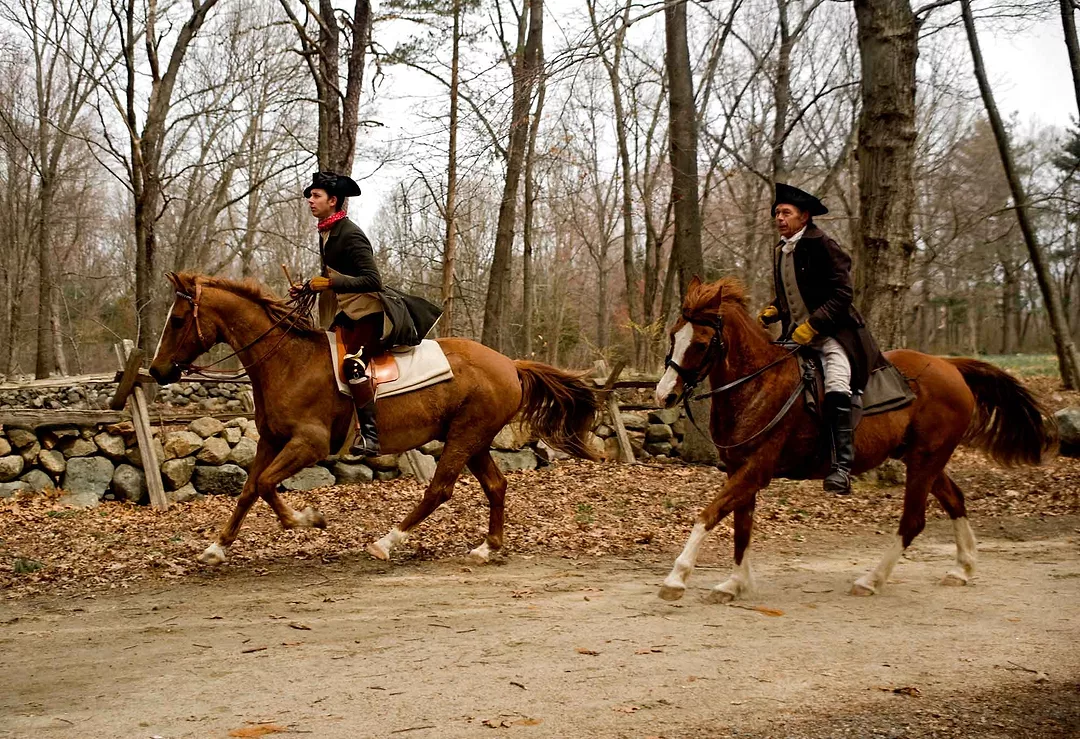The Battle at the North Bridge on April 19, 1775, was well documented, but the running battle of the Minutemen and militia companies chasing the Regular Army out of Concord back to Charlestown along what we now call Battle Road is lesser-known. Records are incomplete and make the first five miles of the retreat impossible to reconstruct accurately. Nevertheless, the National Park Service has hunted down slender clues to provide a more complete history to the forgotten families who experienced fighting on their front lawns. Minute Man National Historical Park Ranger Jim Hollister was able to share some stories about families that lived on the Battle Road.
When you start to explore the Battle Road at Meriam’s Corner you will see Nathan Meriam’s house. However, two houses stood on Meriam’s Corner on April 19, 1775. The house that no longer stands belonged to Josiah Meriam, whose household most certainly saw the line of Redcoats pass their home in the early morning hours. While Josiah Meriam and his older sons fought at North Bridge, his wife and youngest son remained home, for a while. According to William Emerson, most of the women and children of Concord fled into the woods and other places for safety. The Meriams do exactly this and take refuge behind a hill. When they returned to their home, the youngest son was distraught to find some unbaked pies that had been in the oven were gone. The young lad blamed the Regulars; however, it is highly unlikely the Redcoats had taken the pies.
One person that did leave at least a partial record of the fighting along Bay Road was Ensign Jeremy Lister of the 10th Regiment of Foot. As he marched over the hill to Meriam’s Corner he recorded, “immediately as we descended the hill into the Road the Rebels begun a brisk fire but at so great a distance it was without effect, but as they kept marching nearer when the Granadiers found them within shot they returned their fire…it then became a general Firing upon us from all Quarters, from behind hedges and Walls we return’d the fire every opportunity which continued till we arriv’d at Lexington…”1 Thanks to Lister’s entry, we can return to the pilfered pies. The Redcoats were much too busy trying to cross a narrow bridge just past the Merriam homes and dodge the volley from the colonists to stop and eat. What is more likely is some Minutemen or militia men stopped and ate. No matter who ate the pies, the young lad was undoubtedly impacted by the loss of them.

Hartwell Tavern
| ©Beth Van DuzerAbout two and a half miles up the trail lies Hartwell Tavern. That night, Dr. Samuel Prescott most likely alerted the tavern owners, Ephraim and Elizabeth Hartwell, about the incoming column on his way to Concord. Three of Hartwell’s sons fought at North Bridge that morning in the Lincoln Minute company. As the colonists continued hounding the British column back to Boston, the three young men passed right by their home. According to pay records, one son, John Hartwell, was at camp as a Minuteman from April 19-24. On April 24, he enlisted in the Continental Army. Not only did John Hartwell fight at the North Bridge and on the Battle Road, but he also fought at Bunker Hill and was away from his home through December 1775.
Next door to the tavern are the remains of the Samuel Hartwell House. While history is not clear as to whether it was Dr. Prescott or a neighbor that awakened Samuel Hartwell’s family, what is known is Mary Hartwell played a significant role that day by spreading the alarm to neighbors. Mary Hartwell’s heroism was well recognized at that time. Unfortunately, there are so many versions that, without documentation, it is impossible to know which is true. Ultimately, in addition to being remembered as a hero for spreading the alarm to neighbors, Mary Hartwell is also recognized for mourning five unknown, fallen British soldiers during their burial in the Lincoln cemetery. Her care and compassion were her strength.

Captain William Smith House
| commons.wikimedia.orgJust past the tavern, the Battle Road trail is the actual Bay Road. While walking toward the Captain William Smith House, you are walking where history happened. After receiving the alarm, William Smith, captain of the Lincoln Minute company and brother of Abigail Adams, rallied his company, including the Hartwell brothers. The Lincoln Minute company was the first to arrive in Concord later that morning and fought at North Bridge. The company also joined the pursuit of the Regulars back toward Boston. The fighting took William Smith right past his home, but no record exists if he stopped.
The last story to share about April 19 is the Jacob Whittemore House. Jacob and Elizabeth Whittemore were in their mid-fifties and lived in the home with their daughter and son-in-law, Sarah and Moses Reed. The men did not join any of the battles on April 19. Instead, they had to decide whether to uphold duty to their family or their community. Sarah Reed had given birth just weeks before and was in poor health. Whittemore and his son-in-law chose duty to family. They carried Sarah and the newborn into the woods on a mattress to hide from the imminent danger. They apparently stayed with her as Moses Reed did not appear on muster rolls that day. Despite this, just a few weeks after the first shots were fired, Moses did join the Continental Army.
The annual reenactment of April 19, 1775, allows us to relive the extraordinary lives of ordinary people. These lesser-told stories about families that lived on Bay Road on April 19, 1775, provide us with an idea about the fear and anxiety they had that day. As of this writing, there are no public programs currently happening at Minute Man National Historical Park. Nevertheless, if you see a ranger outside one of the Visitor Centers, near North Bridge, or along the Battle Road, ask them to share more of the stories of the forgotten families that called the Battle Road their home.
NOTES
1 Jeremy Lister, Concord Fight: Being so much of the Narrative of Ensign Jeremy Lister of the 10th Regiment of Foot as Pertains to his Services on the 19th of April, 1775, and to his Experiences in Boston during the Early Months of the Siege, (Cambridge: Harvard University, 1931), 69-70. Accessed August 11, 2020. https://archive.org/details/concordfightbein00list/page/n67/mode/2up


